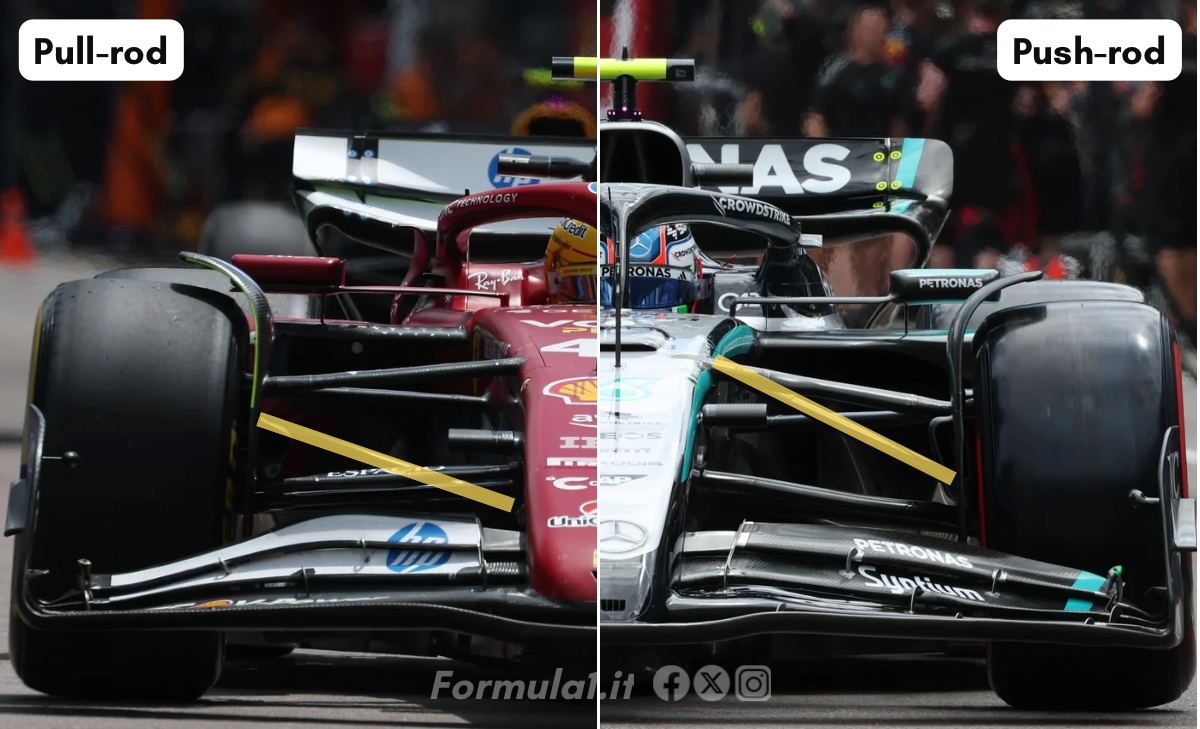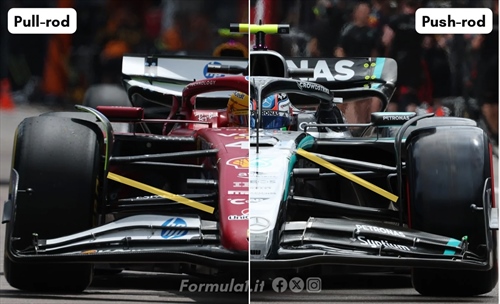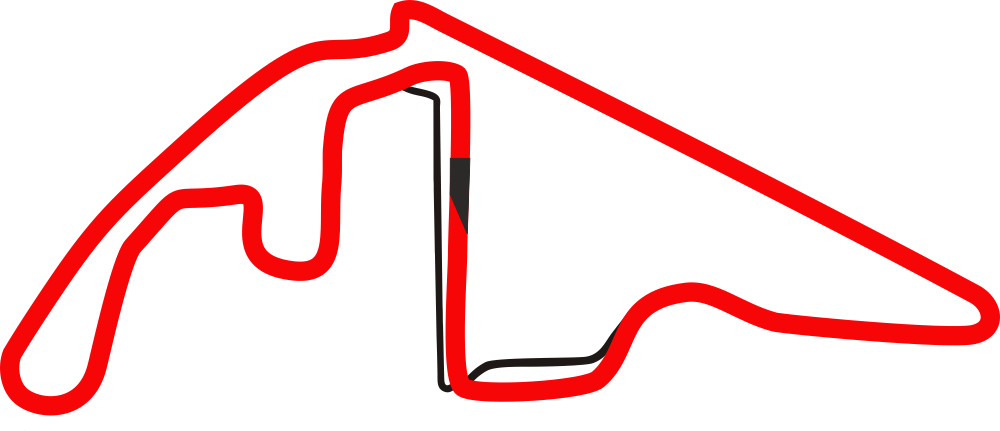The suspension system of a Formula 1 car is one of the most critical elements for its on-track performance. In F1, there are two main configurations: the push-rod and the pull-rod. But what are the differences between them, and why did Ferrari choose to radically overhaul its project in 2025, taking considerable risks? Let’s start by understanding how a suspension system works and the key differences between the two setups.
Components of an F1 Suspension
A Formula 1 suspension system typically includes:
- Upper and lower wishbones (control arms): arranged in an inverted “V” shape (hence “wishbone”), these connect the wheel to the chassis and help maintain its correct alignment during vertical travel, limiting unwanted angles such as camber, caster, and toe. They also absorb lateral forces in corners.
- Rod (either push or pull): connects the wheel assembly to the chassis and transmits motion.
- Rocker: receives the input from the rod and converts it into either compression or tension for the spring and damper.
- Spring and damper: absorb and dissipate energy from bumps, helping the car maintain grip.
Most of these components are also designed with aerodynamic functions in mind, often enclosed in fairings to guide airflow. Additionally, the suspension plays a role in anti-dive geometry (to limit nose dive under braking, improving stability and turn-in) and anti-squat (counteracting rear compression under acceleration).
How Push-Rod and Pull-Rod Work
Both systems connect the wheel to the chassis through a rod, but differ in orientation and mechanical behavior:
- Push-rod: the rod extends upward from the wheel and pushes the rocker arm, compressing the spring and damper. This was the most common solution until recently.
- Pull-rod: the rod is angled downward; as the wheel hits a bump and moves upward, it pulls the rocker arm downward, activating the spring and damper. Many teams have adopted this layout for aerodynamic packaging benefits.
The underlying principle is similar, but the technical implications differ significantly.
Pros and Cons: Push or Pull?
The choice between push-rod and pull-rod is a trade-off, as each has its own advantages and drawbacks.
Aerodynamics and Center of Gravity
- Pull-rod: allows mass to be placed lower and clears space above the chassis, improving airflow under the nose — a key area for current ground-effect cars.
- Push-rod: easier to integrate in the upper part of the chassis, but takes up more space underneath, where airflow to the floor and diffuser is vital.
Maintenance and Accessibility
- Push-rod: easier to disassemble and inspect in the garage, more efficient for trackside maintenance.
- Pull-rod: components are more hidden and less accessible, requiring more time and effort.
Structural Loads
- Push-rod: operates in compression under load; if not stiff enough, it risks flex or failure.
- Pull-rod: works in tension during bump and compression during droop; requires extremely precise geometry and welds.
Summary Table
| Aspect | Pull-rod | Push-rod |
|---|---|---|
| Aerodynamics | Better flow under the nose, lower center of gravity | More blockage below, restricted airflow |
| Accessibility | Harder to maintain | Easy to inspect and adjust |
| Structural Reliability | Requires high construction precision | Potentially more prone to flexing |
2025 Comparison: Suspension Layouts by Team
- Ferrari: pull-rod front and rear
- Red Bull, McLaren, Visa Cash App, and Sauber: pull-rod front, push-rod rear — a proven hybrid layout
- Aston Martin and Alpine: push-rod front and rear
- Mercedes: push-rod front with aggressive geometry, push-rod rear
- Haas: uses Ferrari’s pull-rod rear but retains push-rod front for simplicity
Ferrari SF-25: Revolution or Risk?
For 2025, Ferrari took a bold step: adopting pull-rod suspension on both the front and rear. It marks a return to a concept last seen at the front of a Ferrari in 2015, while continuing the rear layout used with some success in 2024.
Front End: The Pull-Rod Returns
The SF-25 abandoned its previous push-rod front suspension in favor of a pull-rod system, following the example of Red Bull and McLaren since 2022. Developed under Loïc Serra, the aim was to lower the center of gravity and improve airflow under the nose to generate more downforce from the floor. The new setup also allows for more anti-dive geometry, enhancing corner entry under braking.
Rear End: Evolving the Pull-Rod
Ferrari had already implemented a pull-rod rear suspension on the SF-24. For 2025, Cardile’s team further refined the system, lowering the gearbox casing to improve airflow to the rear diffuser.
However, the SF-25’s overhaul went beyond the suspension: it features a longer wheelbase, a rearward-shifted cockpit, redesigned sidepods, and optimized weight distribution. It’s a car built to challenge Red Bull and McLaren on the grounds of aerodynamic aggressiveness — a brave choice stemming from the realization that the previous concept had hit a development ceiling.
Why Has the SF-25 Underperformed?

The root of the issue likely lies in a two-phase development process. While Cardile led the work on the chassis and rear, Loïc Serra focused on the front, introducing a pull-rod system designed to boost performance in fast corners and during corner exit. However, the rear — structurally weaker and prone to flex — failed to fully support the new anti-dive front philosophy.
Using pull-rod suspension at both ends was a bold and high-risk technical choice. While it offered potential aerodynamic advantages, it also demanded extremely precise structural and mechanical execution. The SF-25 has revealed several weaknesses: the team often couldn’t run the optimal ride height from simulations, struggled to hit the correct tire performance window, and gave drivers a car with unpredictable rear behavior.
This may explain Ferrari’s struggles in some races: an elusive balance that prevented stiff setups when needed and caused trouble on circuits with mixed corners. The result? A car that’s difficult to set up, inconsistent in tire management, and unstable in handling.
The New Rear End: Seeking Stability
In Belgium, after three months of intense development, Ferrari will debut a completely redesigned rear end. This includes changes to the gearbox housing — now reinforced to avoid torsional flex — and a repositioning of the suspension arms: the front arm moves forward, the rear arm is shortened, improving force distribution and rear-end support.
This "targeted update" promises more stability, traction, and performance consistency. The on-track feedback from this upgrade will also provide valuable insights for the 2026 season, which will bring major aerodynamic and engine regulation changes. A full article on this update will follow soon.



